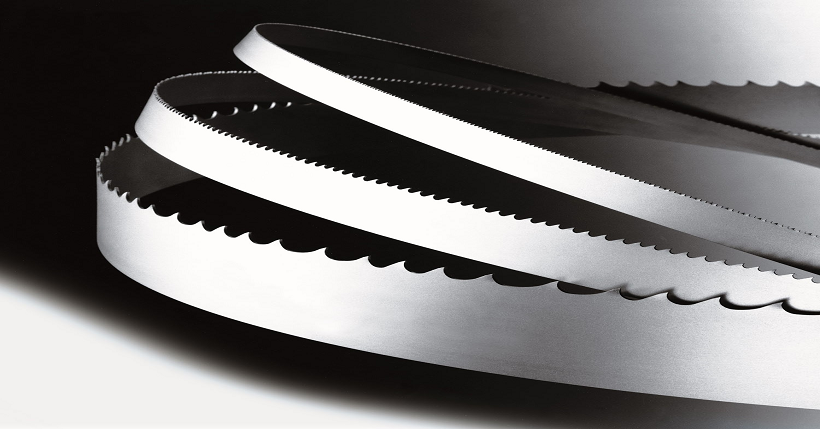
BANDSAW BLADE TEMINOLOGY:
PITCH/TPI- The distance from the tip of one tooth to the tip of the next tooth. This is usually quoted in teeth per inch (T.P.I.). The larger the tooth, the faster the cut, because the tooth has a large gullet and has a greater capacity to transport large amounts of sawdust through the job. Generally, the larger the tooth, the coarser the cut, and the poorer the surface finish of the cut. The smaller the tooth, the slower the cut, as the tooth has a small gullet and cannot transport large amounts of sawdust through the job. The smaller the tooth, the finer the cut and the better the surface finish of the cut. It is normally recommended that you have 6 to 8 teeth engaged in the cut. This is not a rule, only a general guide. If you have fewer teeth engaged, there is a possibility that juddering or vibrating will result, as there is a tendency to over-feed the job and for each tooth to take too deep a cut. If fewer teeth are engaged, there is a tendency to overfill the gullets of the tooth with sawdust. Both problems can be overcome to a degree by adjusting the feed rate. There are certain indications if a blade has the correct pitch or if the pitch is too fine or too coarse.
CORRECT PITCH- Blades cut quickly. A minimum amount of heat is created when the blade cuts. Minimum feeding pressure is required. Minimum horsepower is required. The blade makes quality cuts for a long period.
PITCH IS TOO FINE- The blade cuts slowly. There is excessive heat, causing premature breakage or rapid dulling. Unnecessarily high feeding pressure is required. Unnecessarily high horsepower is required. The blade wears excessively.
PITCH THAT IS TOO COARSE- The blade has a short cutting life. The teeth wear excessively. The band saw or blade vibrates.
THICKNESS- The thickness of the band “gauge.” The thicker the band, the stiffer the blade and the straighter the cut. The thicker the band, the greater the tendency for the blade to break due to stress cracking, and the larger the bandsaw wheels have to be. WHEEL DIAMETER RECOMMENDED BLADE THICKNESS 4-6 Inches .014″ 6-8 Inches .018″ 8-11 Inches .020″ 11-18 Inches .025″ 18-24 Inches .032″ 24-30 Inches .035″ 30 Inches and Over These are the recommended sizes for optimal blade use. If your blade is too thick for your wheel diameter, it will crack. MATERIAL HARDNESS- When choosing the blade with the proper pitch, one factor you should consider is the hardness of the material that is being cut. The harder the material, the finer the pitch that is required. For example, exotic hard woods such as ebony and rosewood require blades with a finer pitch than hard woods such as oak or maple. Soft wood such as pine will quickly clog the blade and decrease its ability to cut. Having a variety of tooth configurations in the same width will most likely give you an acceptable choice for a particular job.
KERF- The width of the saw cut. The larger the kerf, the smaller the radius that can be cut. But the greater the amount of wood that the blade has to cut and the greater the horsepower that is needed, as the blade is doing more work. The greater the kerf, the larger the amount of wood that is being wasted by the cut.
HOOK OR RAKE- The cutting angle or shape of the tooth. The greater the angle, the more aggressive the tooth, and the faster the cut. But the faster the cut, the faster the tooth will blunt, and the poorer the surface finish of the cut. Aggressive blades are suitable for soft woods but will not last when cutting hard woods. The smaller the angle, the less aggressive the tooth, the slower the cut, and the harder the wood that the blade is suitable to cut. Hook teeth have a progressive cutting angle and take the form of a progressive radius. They are used for fast cutting where finish is not important. Rake teeth have a flat cutting angle and are used for fine surface finish of the cut.
GULLET- The area for the sawdust to be transported through the wood. The larger the tooth (pitch), the bigger the gullet.
RAKE ANGLE- The angle from the tip of the tooth back. The greater the angle, the more aggressive the tooth, but the weaker the tooth.
BEAM STRENGTH- This is the ability of the blade to resist bending backwards. The wider the blade, the stronger the beam strength; therefore, a 1″ blade has far greater beam strength than a 1/8″ blade and will cut straighter and is more suitable for resawing.
TOOL TIP- The cutting edge of the saw tooth.
BLADE BACK- The back of the blade that runs on the back blade guide.
BLADE MAINTENANCE- There is not very much that needs to be maintained on the blade, but below are a few points that will help you keep your blade in peak cutting performance.
BLADE CLEANING- Always clean the blade when you take it off the machine. If you leave it gummy or with wood in the gullets, the blade will rust. Rust is the enemy of the woodworker. When you take the blade off the machine or you are not going to use it for some time, it is recommended that you wax the blade. Have a rag that is impregnated with wax that you pull the blade through backward. The wax will coat the blade and will give a degree of protection against rust.
BLADE INSPECTION- Inspect the blade for cracks, dull teeth, rust and general damage every time you put it on the machine. Never use a dull or damaged blade; they are dangerous. If your blade is dull, have it re-sharpened or replace it.
BLADE STORAGE- Store the blade so that the teeth are not damaged and will not cause you injury. One method is to store each blade on a hook with the teeth against a wall. Nail cardboard or a wood sheet on to the wall so that the teeth are protected from damage, and if you brush against the blade it will not cause injury.














